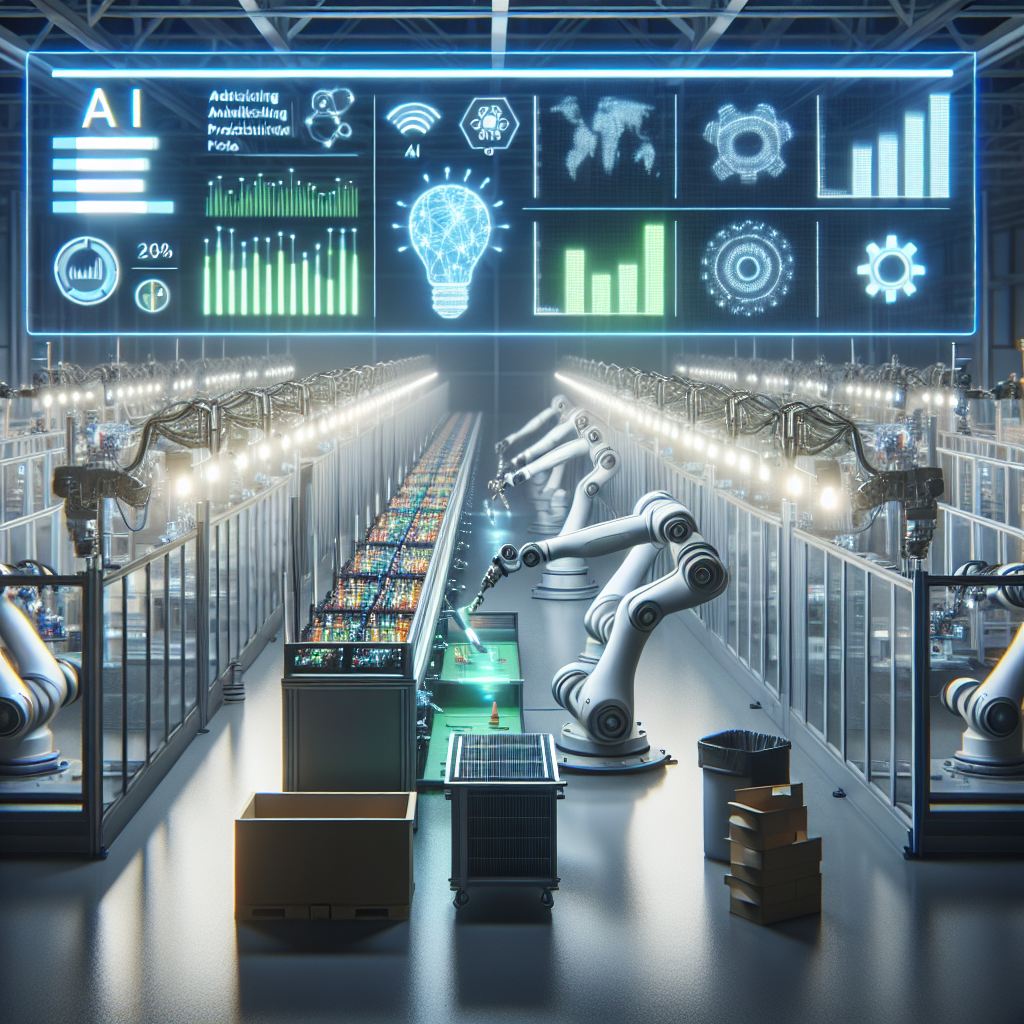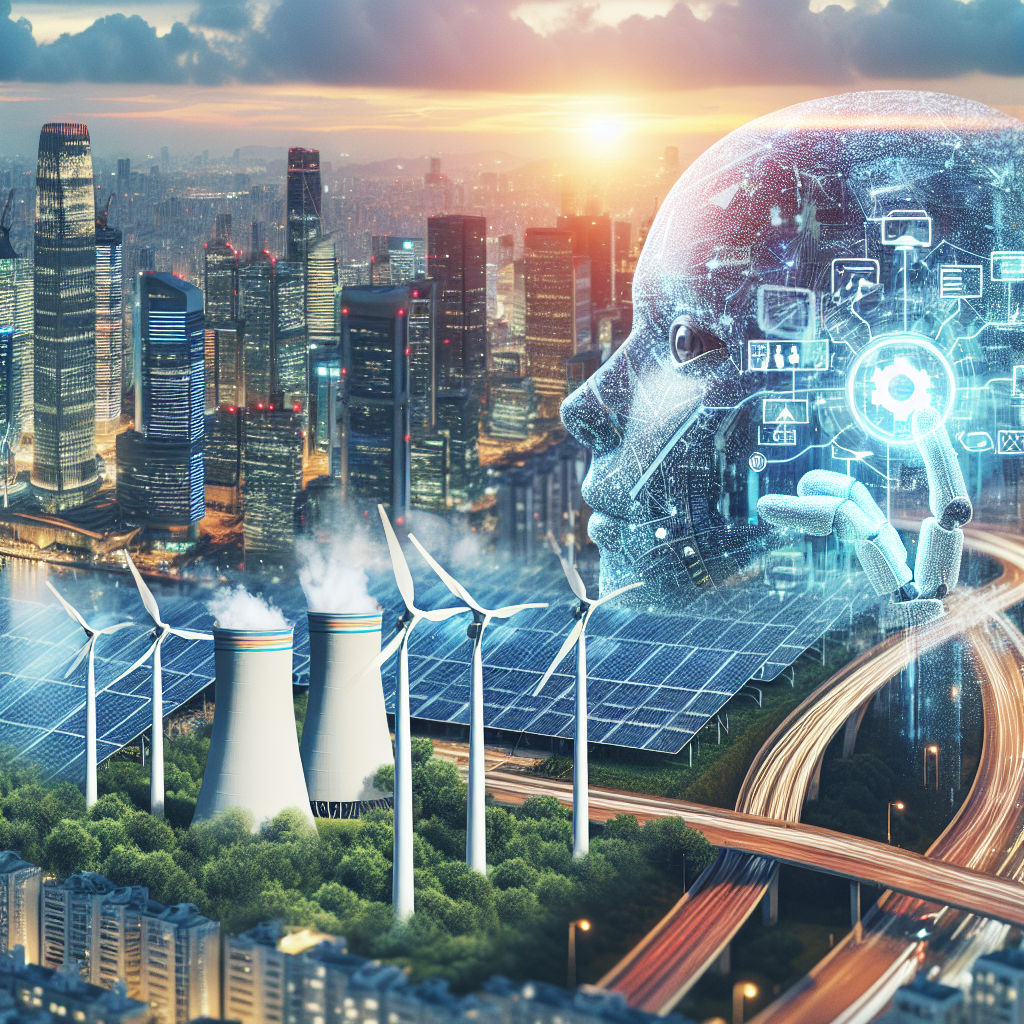The Role of AI in Sustainable Manufacturing
Artificial Intelligence (AI) plays a pivotal role in driving sustainability within the manufacturing sector by offering innovative solutions that significantly reduce waste and energy consumption. AI technologies enable manufacturers to optimize their processes through real-time data analysis and automation, leading to more efficient resource utilization. By integrating AI into manufacturing operations, companies can achieve a delicate balance between productivity and environmental responsibility.
One of the key applications of AI in sustainable manufacturing is predictive maintenance. This approach utilizes AI algorithms to analyze sensor data from machinery and predict potential failures before they occur. This not only minimizes downtime but also extends the lifespan of equipment, thereby reducing the need for frequent replacements and conserving resources. Additionally, predictive maintenance helps in lowering energy consumption as machines can be operated at optimal efficiency.
AI also contributes to sustainability through supply chain optimization. By analyzing patterns and trends, AI can help manufacturers streamline their supply chains, reduce excess inventory, and minimize transportation emissions. AI-driven insights allow for more precise demand forecasting and inventory management, which leads to less waste and more efficient use of materials. Moreover, AI can assist in identifying suppliers with sustainable practices, further enhancing the overall sustainability of the manufacturing process.
Furthermore, AI aids in sustainable design by simulating and evaluating numerous design scenarios to identify the most eco-friendly options. This process involves assessing the environmental impact of different materials and processes to ensure that products are designed with sustainability in mind. AI tools can also facilitate the creation of lightweight and durable products that require fewer resources to manufacture and transport, ultimately contributing to a reduction in the carbon footprint of manufacturing activities.
Reducing Waste Through AI
Artificial Intelligence (AI) is playing a pivotal role in minimizing waste within the manufacturing sector. By leveraging AI-driven analytics and machine learning algorithms, manufacturers can identify inefficiencies in their production processes and implement strategies to mitigate waste. One of the primary ways AI achieves this is through predictive maintenance. This approach utilizes sensors and AI models to predict when equipment is likely to fail, allowing for timely maintenance that prevents unnecessary downtime and material waste. For instance, a study showed that predictive maintenance can reduce machine downtime by up to 50% and extend machinery life by 20%.
Moreover, AI enhances the precision of quality control systems, reducing the waste generated from defective products. AI systems can analyze production data in real-time to detect anomalies and ensure that each product meets the required standards before it leaves the production line. This not only reduces the volume of waste but also ensures that resources are used efficiently throughout the manufacturing process. The implementation of AI in quality control has been shown to decrease defect rates by 30% in some industries, further underscoring its potential to drive sustainability.
In addition to maintenance and quality control, AI optimizes inventory management and supply chain logistics, which are critical in reducing material waste. AI algorithms can accurately forecast demand and adjust inventory levels accordingly, minimizing overproduction and the excess storage of materials. This application of AI not only reduces waste but also cuts down on unnecessary energy consumption associated with the production and storage of surplus goods. An analysis of companies using AI for inventory management reported a reduction in inventory costs by 20-30%, demonstrating the economic and environmental benefits of integrating AI technologies.
| AI Application | Benefit | Waste Reduction |
|---|---|---|
| Predictive Maintenance | Reduces machine downtime and extends machinery life | Up to 50% reduction in downtime |
| Quality Control | Improves product standards and reduces defects | 30% decrease in defect rates |
| Inventory Management | Optimizes stock levels and supply chain logistics | 20-30% reduction in inventory costs |
AI-Driven Energy Efficiency
AI-driven energy efficiency is revolutionizing the way manufacturing facilities manage their energy consumption, leading to substantial cost savings and environmental benefits. By leveraging advanced algorithms and machine learning models, AI systems can analyze vast amounts of data to identify patterns and optimize energy usage across various processes. One significant application of AI in this domain is in the optimization of heating, ventilation, and air conditioning (HVAC) systems. These systems can consume a large portion of a facility’s energy, but with AI, they can be fine-tuned to operate only when needed and at optimal levels, drastically reducing unnecessary energy use.
Another critical area where AI is making a significant impact is in real-time energy monitoring and management. By installing smart sensors throughout a manufacturing plant, AI can provide real-time insights into energy consumption patterns. This data allows facility managers to make informed decisions about when and where to cut back on energy use. It also helps in identifying energy leaks or inefficiencies that would otherwise go unnoticed. Additionally, AI can predict future energy needs, allowing facilities to adjust their operations proactively, thus avoiding peak energy charges and reducing overall consumption.
The implementation of AI in energy management extends to the integration of renewable energy sources. AI algorithms can predict the availability of renewable energy sources, such as solar or wind, and dynamically adjust the manufacturing process to take full advantage of these sustainable energy options. This not only reduces dependency on non-renewable energy but also enhances the overall sustainability of the manufacturing process.
| AI Application | Energy Savings Potential | Example |
|---|---|---|
| Predictive Maintenance | Up to 30% | Reduces downtime and energy waste by predicting equipment failures |
| Smart HVAC Systems | Up to 40% | Optimizes climate control systems to reduce energy consumption |
| Renewable Energy Integration | Varies | Maximizes use of solar and wind energy when available |
Predictive Maintenance and Sustainability
Predictive maintenance is a key application of AI in manufacturing that significantly enhances sustainability. By utilizing AI algorithms to analyze data from equipment sensors, manufacturers can predict when a machine is likely to fail and perform maintenance just in time, rather than following a fixed schedule. This approach not only minimizes unexpected downtime but also reduces waste associated with over-maintenance and extends the lifespan of equipment. Companies implementing predictive maintenance have reported up to a 30% reduction in maintenance costs and a 70% decrease in breakdowns.
Furthermore, predictive maintenance contributes to energy conservation. Machines operating optimally consume less energy, leading to a reduction in overall energy consumption. This efficiency in energy use aligns with global sustainability goals by lowering the carbon footprint of manufacturing operations. A study highlighted in the article shows that factories employing AI-driven predictive maintenance practices experienced an average of 10-15% reduction in energy consumption.
The following table illustrates the benefits of predictive maintenance:
| Benefit | Impact |
|---|---|
| Reduced Maintenance Costs | Up to 30% |
| Decrease in Equipment Breakdowns | Up to 70% |
| Energy Consumption Reduction | 10-15% |
In conclusion, predictive maintenance is a powerful tool in the quest for sustainable manufacturing. By leveraging the capabilities of AI, manufacturers can not only optimize their operations but also contribute to environmental sustainability. As AI technology continues to evolve, its role in enhancing predictive maintenance and sustainability is expected to expand, offering even greater benefits in the future.
Optimizing Supply Chains with AI
The integration of AI into supply chain management is revolutionizing the manufacturing industry by enhancing efficiency and sustainability. AI technologies such as machine learning algorithms and data analytics are being employed to streamline operations, reduce costs, and minimize environmental impact. By leveraging AI, companies can gain deeper insights into their supply chains, enabling them to make more informed decisions that lead to reduced waste and optimized energy usage.
One of the key applications of AI in supply chains is predictive analytics, which allows manufacturers to anticipate demand more accurately and adjust production schedules accordingly. This reduces overproduction and minimizes inventory waste. AI-driven demand forecasting models analyze historical data and market trends to predict future demand, ensuring that resources are used efficiently. Furthermore, AI can optimize logistics by selecting the most efficient routes for transportation, thereby reducing fuel consumption and emissions.
Another significant advantage of AI in supply chains is its ability to enhance supplier management and procurement processes. By analyzing supplier performance data, AI systems can identify the most reliable and sustainable suppliers, promoting a greener supply chain. AI can also automate the procurement process, reducing human error and ensuring that materials are sourced sustainably. Additionally, AI can support real-time monitoring of supply chain activities, allowing for quick responses to disruptions, which is critical for maintaining sustainability goals.
The following table illustrates the potential benefits of AI in supply chain optimization:
| AI Application | Benefit | Impact on Sustainability |
|---|---|---|
| Predictive Analytics | Accurate demand forecasting | Reduces overproduction and waste |
| Logistics Optimization | Efficient route planning | Decreases fuel consumption and emissions |
| Supplier Management | Identifies sustainable suppliers | Enhances overall supply chain sustainability |
AI for Sustainable Design
Artificial Intelligence is playing a pivotal role in revolutionizing sustainable design within the manufacturing sector. By leveraging AI-driven tools, manufacturers can significantly minimize material usage and optimize production processes. One of the primary benefits of AI in sustainable design is its ability to analyze vast datasets to identify patterns and insights that might not be evident through traditional methods. This capability enables manufacturers to reduce waste by designing products that use fewer resources while maintaining quality and functionality.
AI technologies, such as generative design, allow designers to input specific parameters like material type, manufacturing methods, and performance criteria. The AI then generates a multitude of design alternatives, often uncovering innovative solutions that a human might not consider. This not only fosters creativity but also ensures that the end design is optimized for sustainability. For instance, aerospace and automotive industries have successfully utilized AI to design components that are lighter and stronger, reducing both material waste and energy consumption during production.
Furthermore, AI aids in life cycle assessment (LCA), providing a comprehensive view of a product’s environmental impact from raw material extraction to end-of-life disposal. By integrating AI into LCA, manufacturers can quickly simulate and assess various design scenarios, choosing options that minimize environmental footprints. This proactive approach in sustainable design promotes a circular economy, encouraging the reuse and recycling of materials.
| AI Application | Function | Benefit |
|---|---|---|
| Generative Design | Generates multiple design options based on set parameters | Reduces material usage and enhances product performance |
| Life Cycle Assessment (LCA) | Evaluates environmental impact throughout product life | Identifies sustainable design choices and reduces carbon footprint |
In conclusion, the integration of AI in sustainable design is not just a technological advancement but a necessity for the future of manufacturing. By adopting AI-driven sustainable design practices, manufacturers can ensure that they are not only meeting consumer demands for greener products but also contributing to global sustainability efforts.
The Impact of AI on Material Usage
Artificial Intelligence (AI) is revolutionizing the way materials are utilized in manufacturing, driving significant advancements in sustainability. By leveraging AI technologies, manufacturers can optimize material usage, significantly reducing waste and enhancing resource efficiency. AI systems can analyze vast amounts of data to identify patterns and make predictions, allowing for smarter decision-making regarding material procurement and usage. This shift not only minimizes excess material consumption but also lowers production costs and environmental impact.
One of the primary ways AI impacts material usage is through predictive analytics. By employing machine learning algorithms, manufacturers can forecast material demand more accurately, ensuring that the right amount of materials are ordered and used. This reduces overstock and understock situations, which are common sources of waste in traditional manufacturing processes. Furthermore, AI-driven analytics can help identify areas where materials can be reused or recycled, promoting a circular economy within the manufacturing industry.
AI also plays a crucial role in improving design processes, which directly affects material usage. Through AI-powered simulations and generative design, manufacturers can create more efficient product designs that require fewer materials without compromising quality. These technologies allow for the exploration of a broader range of design possibilities, ensuring optimal material use. Below is a table showcasing the potential reduction in material usage through AI-driven design improvements:
| Traditional Design | AI-Driven Design |
|---|---|
| Material Usage: 100% | Material Usage: 70% |
| Waste: 20% | Waste: 5% |
Additionally, AI facilitates better supply chain management, which is vital for efficient material usage. By optimizing supply chain operations through AI, manufacturers can ensure that materials are moved and stored more efficiently, reducing the likelihood of spoilage or obsolescence. AI can analyze complex supply chain networks to identify bottlenecks and inefficiencies, enabling more streamlined operations. This not only conserves materials but also enhances the overall sustainability of manufacturing operations.
AI and Circular Economy Practices
Artificial Intelligence (AI) is playing a pivotal role in advancing circular economy practices within the manufacturing sector. By integrating AI technologies, manufacturers are able to optimize resource utilization, thereby minimizing waste and enhancing the lifecycle of products. AI-driven analytics allow companies to precisely predict demand, adjust production schedules, and manage inventory efficiently, reducing excess production and overstock situations that contribute to waste.
One of the core aspects of circular economy practices is the ability to recycle and reuse materials. AI applications in material sorting and recycling processes are making significant strides. For instance, AI-powered vision systems can accurately identify and sort different types of materials, increasing the efficiency and effectiveness of recycling operations. This not only reduces the amount of waste sent to landfills but also lowers the demand for raw materials.
| AI Application | Impact on Circular Economy |
|---|---|
| Predictive Maintenance | Extends the lifespan of machinery, reducing the need for new resources |
| Resource Optimization | Minimizes waste through precise demand forecasting and production planning |
| Material Sorting | Enhances recycling efficiency by accurate material identification |
Moreover, AI is also facilitating the development of closed-loop systems in manufacturing. These systems ensure that products are designed with their end-of-life in mind, enabling easier disassembly and recycling. Machine learning algorithms analyze product usage data to suggest design improvements that enhance durability and recyclability. Such innovations are crucial for establishing a sustainable manufacturing model that aligns with circular economy principles.
In conclusion, the integration of AI in circular economy practices is not just a theoretical concept but a tangible reality that is reshaping the manufacturing landscape. With the continuous advancements in AI technologies, the potential for more sustainable manufacturing processes, which significantly reduce waste and energy consumption, is immense. As these technologies mature, they will undoubtedly play a critical role in the transition towards a more sustainable and circular manufacturing industry.
Challenges and Opportunities in Sustainable AI
Challenges: The implementation of AI in manufacturing for sustainability purposes presents several challenges. One major hurdle is the integration of AI technologies into existing systems. Many manufacturing facilities operate with legacy systems that are not designed to accommodate advanced AI applications. This necessitates significant investment in upgrading infrastructure, which can be a deterrent for many organizations. Additionally, data quality and availability pose a significant challenge. AI systems rely on vast amounts of data to function effectively, and inconsistent or incomplete data can hinder their performance.
Another challenge is the energy consumption of AI systems themselves. While AI can optimize energy use in manufacturing, the computational power required for AI algorithms can be substantial, potentially offsetting some of the energy savings. Furthermore, there is a skills gap in the workforce, as the deployment of AI technologies requires specialized knowledge that is not yet widespread in the industry. Organizations must invest in training and development to bridge this gap, which can be both time-consuming and costly.
Opportunities: Despite these challenges, there are significant opportunities for AI to drive sustainability in manufacturing. AI technologies can lead to enhanced predictive maintenance, reducing downtime and minimizing waste from defective products. By analyzing patterns and predicting equipment failures, AI can help schedule maintenance activities more efficiently, thus extending the lifespan of machinery and reducing resource consumption.
Moreover, AI can revolutionize supply chain optimization. Through advanced analytics and real-time data processing, AI can streamline logistics, reduce excess inventory, and minimize transportation emissions. The use of AI in sustainable design also presents a vast opportunity. By analyzing material properties and environmental impact, AI can assist in designing products that are more sustainable from the outset. This holistic approach not only reduces waste but also aligns with the growing consumer demand for environmentally friendly products.
Case Studies in Sustainable AI Manufacturing
In recent years, numerous manufacturing companies have successfully integrated AI technologies into their operations, leading to significant reductions in waste and energy consumption. One notable example is a global automotive manufacturer that implemented predictive maintenance across its production lines. By utilizing AI algorithms to monitor equipment health in real-time, the company was able to identify potential failures before they occurred. This proactive approach not only minimized downtime but also led to a 15% reduction in energy consumption and a substantial decrease in material waste.
Another compelling case study involves a leading electronics company that leveraged AI for supply chain optimization. By analyzing vast amounts of data from multiple sources, the company optimized inventory levels and improved logistics efficiency. This AI-driven strategy resulted in a 30% reduction in excess inventory and a significant decrease in carbon emissions from transportation. The company’s commitment to sustainability was further enhanced by implementing AI in sustainable design, enabling the development of products that are easier to recycle and have a lower environmental impact.
Moreover, a prominent consumer goods manufacturer utilized AI to enhance its energy management systems. By integrating AI with IoT sensors, the company achieved real-time monitoring and control of energy usage across its facilities. This initiative led to a 20% reduction in overall energy consumption, demonstrating the potential of AI in driving sustainable practices. The company also shared insights into their approach through a detailed study, which highlighted the importance of continuous data analysis and adaptive algorithms in achieving long-term sustainability goals.
The following table summarizes the key outcomes from these case studies:
| Company | AI Application | Outcome |
|---|---|---|
| Global Automotive Manufacturer | Predictive Maintenance | 15% reduction in energy consumption, decreased material waste |
| Electronics Company | Supply Chain Optimization & Sustainable Design | 30% reduction in excess inventory, reduced carbon emissions |
| Consumer Goods Manufacturer | Energy Management Systems | 20% reduction in overall energy consumption |
Future Trends in Sustainable AI
Future trends in sustainable AI in manufacturing are poised to revolutionize the industry by driving further efficiencies and sustainability. One key trend is the integration of advanced machine learning algorithms that can process vast amounts of data in real-time. This capability enables manufacturers to identify patterns and anomalies that were previously undetectable, leading to more informed decision-making and enhanced predictive maintenance. By predicting equipment failures before they occur, companies can significantly reduce waste associated with unexpected downtime and extend the lifespan of their machinery.
Another promising trend is the development of AI-driven supply chain optimization. As AI becomes more sophisticated, it can model and predict supply chain disruptions with greater accuracy. This foresight allows manufacturers to proactively adjust their operations, thereby minimizing waste and improving energy efficiency. For instance, AI can analyze factors such as weather patterns, geopolitical events, and market trends to optimize inventory levels and transportation routes. As a result, companies can achieve a more sustainable supply chain by reducing excess inventory and lowering carbon emissions.
The rise of sustainable design is also a noteworthy trend. AI technologies are enabling manufacturers to create products with sustainability in mind from the outset. By using AI to simulate and evaluate different design scenarios, companies can optimize material usage and energy consumption during the manufacturing process. Moreover, AI can help in selecting eco-friendly materials and designing for recyclability, which contributes to a circular economy. This shift towards sustainable design not only reduces the environmental impact but also meets the growing consumer demand for environmentally responsible products.
Finally, the future of sustainable AI in manufacturing will likely see increased collaboration between cross-industry stakeholders. As companies recognize the importance of sustainability, there will be a greater push towards sharing data and insights across sectors. This collaborative approach can lead to the development of industry-wide standards and best practices for sustainable manufacturing. A focus on transparency and accountability will drive innovation and ensure that AI technologies are used ethically and efficiently to promote sustainability.
Policy and Regulation Considerations
Policy and regulation play pivotal roles in steering the development and implementation of sustainable AI technologies in the manufacturing sector. Governments worldwide are increasingly recognizing the potential of AI to enhance sustainability and are enacting policies to support its integration. These policies are designed to incentivize manufacturers to adopt AI-driven approaches that minimize waste and reduce energy consumption. By setting clear guidelines and standards, regulatory bodies help ensure that AI applications align with broader environmental goals.
One key area of focus for policy makers is data governance. Effective data management is crucial for the successful deployment of AI in manufacturing, as AI models rely on vast amounts of data to make accurate predictions and optimizations. Regulations must address data privacy and security concerns while also promoting data sharing and interoperability. This balance can be achieved through frameworks that encourage transparency and trust between stakeholders, facilitating the collaborative use of AI technologies across the supply chain.
Another important consideration is the establishment of incentives and subsidies for manufacturers that invest in sustainable AI solutions. Governments can offer tax breaks, grants, or low-interest loans to companies that demonstrate a commitment to reducing their environmental footprint through AI. These financial incentives can accelerate the adoption of AI technologies, making it economically viable for more businesses to transition to sustainable practices.
Finally, international cooperation is essential for addressing the global nature of manufacturing supply chains. Harmonizing regulations across borders can prevent regulatory fragmentation and ensure that sustainable AI practices are adopted consistently worldwide. Collaborative efforts between nations can lead to the development of global standards for sustainable AI in manufacturing, promoting widespread benefits and leveling the playing field for all participants.
AI’s Role in Carbon Footprint Reduction
Artificial Intelligence (AI) is playing a pivotal role in the reduction of carbon footprints within the manufacturing sector. By leveraging AI technologies, companies are not only able to monitor and analyze energy usage but also predict future consumption patterns, enabling more informed decision-making. One of the primary ways AI contributes to carbon footprint reduction is through the optimization of energy-intensive processes. AI algorithms can identify inefficiencies in these processes and suggest modifications that significantly decrease energy usage, thereby reducing overall emissions.
Another significant application of AI in this realm is predictive maintenance. By using AI-driven sensors and data analytics, manufacturers can predict when machinery is likely to fail or operate inefficiently. This foresight allows for timely maintenance, which prevents unexpected breakdowns and reduces the energy wasted in unproductive machine operations. Furthermore, predictive maintenance extends the lifespan of equipment, minimizing the environmental impact associated with manufacturing new machinery.
AI also facilitates supply chain optimization, which is crucial for minimizing carbon emissions. By analyzing vast datasets, AI can optimize logistics and transportation routes, reducing the fuel consumption and emissions associated with product distribution. Additionally, AI models can forecast demand more accurately, reducing overproduction and the associated waste. This not only contributes to a lower carbon footprint but also enhances the overall sustainability of manufacturing operations.
To illustrate the impact of AI on carbon footprint reduction, consider the following data visualization showing the potential decrease in emissions through AI applications:
| AI Application | Potential Emission Reduction (%) |
|---|---|
| Predictive Maintenance | 20% |
| Energy Optimization | 30% |
| Supply Chain Efficiency | 25% |
These figures underscore the transformative potential of AI in making manufacturing processes more sustainable, setting a precedent for industries worldwide to follow suit in the pursuit of environmental stewardship.



